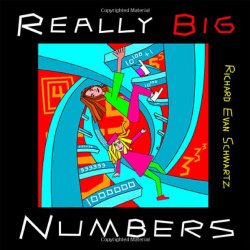
 Really Big Numbers
Really Big NumbersAmerican Mathematical Society, 2014.
Starred Review
2014 Mathical Books Award Winner
2015 Sonderbooks Stand-out: #1 Picture Books
Full disclosure: When I visited the National Math Festival and met Richard Evan Schwartz, I got all fangirl about his book You Can Count on Monsters and showed him my prime factorization cardigan. Of course I purchased his new book and got it signed. I am particularly proud of what he wrote: “To Sondy, Beautiful cardigan! It looks like we have a lot of the same ideas. Best wishes, Richard Schwartz”
And when I showed him my Pascal’s Triangle Shawl, he gave me the idea of making a new one using congruences mod n. Yes! I like the way this man thinks!
[In fact, in a weird side note, after reading his bio on the AMS webpage and learning he did his undergrad in math at UCLA, I find myself with a memory -- which very well may be false -- of taking a class with him as an undergraduate when I was a graduate math student at UCLA. I took a class (Number Theory?) with some undergraduates. That was in 1985-1986. An internet search shows he got his PhD in 1991 -- so this is actually possible! And I remember a cocky and extremely intelligent student who looked a whole lot like he does now, only younger....]
You will not be surprised when I say I loved his new book! There are many books that deal with large numbers using analogies. A few from the beginning of this book include:
About 7 billion people live on Earth. If they all lined up, spaced about a foot apart, they would circle 50 times or so around the equator.
You could cram about 20 billion grains of very fine sand into a basketball.
100 billion basketballs would fill New York City roughly to the height of a man.
You could cover the service of the earth with about a quadrillion (10^15) exercise trampolines.
A quintillion (10^18) grains of very fine sand would just about cover Atlantic City, NJ, to a depth of 3 feet.
Speaking of a quadrillion and a quintillion, I’ve seen a few other books that explain the names for large numbers, but that’s only about the halfway point of this book! You know things are getting interesting right after the page where he shows this chart:
10^21 sextillion
10^24 septillion
10^27 octillion
10^30 nonillion
10^33 decillion
The next page says, “This system goes quite far out but I think that these names lose their novelty after the first 30 or so.” On that page we see spectators sleeping or reading a newspaper. Here’s the chart:
10^36 undecillion
10^39 duodecillion
10^42 tredecillion
10^45 quattourdecillion
10^48 quindecillion
On the page facing that one, he says, “Here, let me skip ahead some and show you the names of a few really big ones.”
10^78 quinquavigintillion
10^93 trigintillion
10^108 quinquatrigintillion
10^123 quadragintillion
10^153 quinquagintillion
Since this is still only about the halfway point of the book, you get the idea that when this book talks about really big numbers, it means really big numbers!
The author throws in questions about the big numbers – questions challenging enough to get even an adult with a math degree thinking.
There are more illustrations of the size of things, such as:
The sun, the true giant in the solar system, has about 4 nonillion (4x10^30) pounds of material.
We could continue counting up roughly by powers of 1000, moving out beyond the solar system to the stars surrounding the sun and eventually to galaxies and galaxy clusters, and superclusters, outward even to supercluster filaments and membranes…
but if you want to see some REALLY big numbers, we will have to move faster than that.
What is this author’s idea of REALLY big numbers? Well, before long, we get to a googol (10^100).
A googol atoms would fill the observable universe about 100 quadrillion times over.
You could say that a googol is so big that it rises beyond the merely astronomical.
He gives more illustrations of how big a googol is, but then says:
Yeah, a googol is a pretty big number.
But if you want to talk about REALLY big numbers then we’ll have to move on to a new level of abstraction. So, get ready, because the ride is gonna be pretty bumpy from here on in. But, remember, this book is supposed to be like a game of bucking bronco and you can always come back to it later if you fall off now.
All of this is accompanied by helpful and/or amusing computer cartoon illustrations.
So, then, the first abstract thing I want to tell you about is called plex.
When you “plex” a number, you write 1 followed by that number of zeros.
In other words, when you plex a number, you raise 10 to that power.
A googol-plex is 1 followed by a googol zeros, or, equivalently, 10 raised to the googol power.
A googol-plex is also 100-plex-plex and likewise 2-plex-plex-plex.
I love this page:
In my experience it is impossible to picture a googol-plex in concrete terms. Any attempt will scramble your brain. An implacable guard blocks the door to that kind of intuition.
But, let’s try to sneak by the guard and see what we can.
After some attempts at that, he says:
Mathematics gives us a language to name all kinds of things, but we can’t relate to everything we can name. If you want to think about REALLY big numbers, you have to give up the idea of picturing them….
Just let go of the reins and let LANGUAGE gallop on.
He even explains Recursion – “the trick of making something new by applying a simple rule over and over.”
Then he looks at some numbers plexed multiple times. I just love when he starts making up his own names.
Here is the number “one plexed one plexed two times times.” [The diagram here is very helpful.]
This number has no familiar name, so let’s call it “Fred.”
Let’s unravel “Fred” from the inside out.
“one plexed two times” is 1010, or ten billion, so “Fred” means “one plexed ten billion times.”
And here is “1 plexed FRED times.”
Let’s call this number “Big Jim.”
You may ask, “How big are ‘Fred’ and ‘Big Jim’?”
I’ll tell you honestly: I don’t know! Already, “1 plexed 4 times” makes a googol-plex seem microscopic, and each new plex is a quantum leap forward in size and abstraction.
To get to “Fred” you take 10 billion quantum leaps.
And “Big Jim” is “Fred” quantum leaps away.
And Richard Schwartz still doesn’t stop there! At the end of the book, he starts introducing new symbols. He shows a square that means “1 plexed N times.” Then he makes a new symbol that builds off of the square, and further symbols that build off of that.
Accompanied by diagrams with these new symbols, he says:
Once you get a taste for this kind of symbol, and the accelerated voyage it lets you take through the number system, nothing stops you from making more symbols.
Each new addition to the language is a chariot moving so quickly it makes all the previous ones seem to stand still.
We skip from chariot to chariot, impatient with them almost as soon as they are created.
Unhindered by any ties to experience, giddy with language, we race ever faster through the number system.
When you finally reach the last page, you will agree with the final line:
Infinity is farther away than you thought.
I’ve quoted extensively from this book, but believe me, quotes out of context pale in contrast with the actual book – I’m simply giving you a clue as to what you’ll find here. The illustrations, symbols, and diagrams all help lead the train of thought, or I should say ladder of thought, or better yet supersonic jet of thought.
I wish I had this book when my boys were young! My oldest, when he was in Kindergarten, liked to make up words for numbers “bigger than infinity.” I think the way this book is presented, the ideas of larger and larger numbers – bounded only by your imagination – would have inspired both my sons. I definitely plan to show this to kids at the library.
